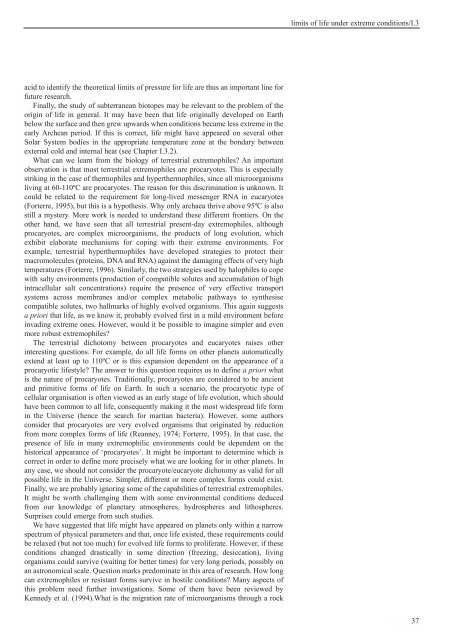Exobiology in the Solar System & The Search for Life on Mars - ESA
Exobiology in the Solar System & The Search for Life on Mars - ESA
Exobiology in the Solar System & The Search for Life on Mars - ESA
You also want an ePaper? Increase the reach of your titles
YUMPU automatically turns print PDFs into web optimized ePapers that Google loves.
acid to identify <str<strong>on</strong>g>the</str<strong>on</strong>g> <str<strong>on</strong>g>the</str<strong>on</strong>g>oretical limits of pressure <str<strong>on</strong>g>for</str<strong>on</strong>g> life are thus an important l<str<strong>on</strong>g>in</str<strong>on</strong>g>e <str<strong>on</strong>g>for</str<strong>on</strong>g><br />
future research.<br />
F<str<strong>on</strong>g>in</str<strong>on</strong>g>ally, <str<strong>on</strong>g>the</str<strong>on</strong>g> study of subterranean biotopes may be relevant to <str<strong>on</strong>g>the</str<strong>on</strong>g> problem of <str<strong>on</strong>g>the</str<strong>on</strong>g><br />
orig<str<strong>on</strong>g>in</str<strong>on</strong>g> of life <str<strong>on</strong>g>in</str<strong>on</strong>g> general. It may have been that life orig<str<strong>on</strong>g>in</str<strong>on</strong>g>ally developed <strong>on</strong> Earth<br />
below <str<strong>on</strong>g>the</str<strong>on</strong>g> surface and <str<strong>on</strong>g>the</str<strong>on</strong>g>n grew upwards when c<strong>on</strong>diti<strong>on</strong>s became less extreme <str<strong>on</strong>g>in</str<strong>on</strong>g> <str<strong>on</strong>g>the</str<strong>on</strong>g><br />
early Archean period. If this is correct, life might have appeared <strong>on</strong> several o<str<strong>on</strong>g>the</str<strong>on</strong>g>r<br />
<str<strong>on</strong>g>Solar</str<strong>on</strong>g> <str<strong>on</strong>g>System</str<strong>on</strong>g> bodies <str<strong>on</strong>g>in</str<strong>on</strong>g> <str<strong>on</strong>g>the</str<strong>on</strong>g> appropriate temperature z<strong>on</strong>e at <str<strong>on</strong>g>the</str<strong>on</strong>g> b<strong>on</strong>dary between<br />
external cold and <str<strong>on</strong>g>in</str<strong>on</strong>g>ternal heat (see Chapter I.3.2).<br />
What can we learn from <str<strong>on</strong>g>the</str<strong>on</strong>g> biology of terrestrial extremophiles? An important<br />
observati<strong>on</strong> is that most terrestrial extremophiles are procaryotes. This is especially<br />
strik<str<strong>on</strong>g>in</str<strong>on</strong>g>g <str<strong>on</strong>g>in</str<strong>on</strong>g> <str<strong>on</strong>g>the</str<strong>on</strong>g> case of <str<strong>on</strong>g>the</str<strong>on</strong>g>rmophiles and hyper<str<strong>on</strong>g>the</str<strong>on</strong>g>rmophiles, s<str<strong>on</strong>g>in</str<strong>on</strong>g>ce all microorganisms<br />
liv<str<strong>on</strong>g>in</str<strong>on</strong>g>g at 60-110ºC are procaryotes. <str<strong>on</strong>g>The</str<strong>on</strong>g> reas<strong>on</strong> <str<strong>on</strong>g>for</str<strong>on</strong>g> this discrim<str<strong>on</strong>g>in</str<strong>on</strong>g>ati<strong>on</strong> is unknown. It<br />
could be related to <str<strong>on</strong>g>the</str<strong>on</strong>g> requirement <str<strong>on</strong>g>for</str<strong>on</strong>g> l<strong>on</strong>g-lived messenger RNA <str<strong>on</strong>g>in</str<strong>on</strong>g> eucaryotes<br />
(Forterre, 1995), but this is a hypo<str<strong>on</strong>g>the</str<strong>on</strong>g>sis. Why <strong>on</strong>ly archaea thrive above 95ºC is also<br />
still a mystery. More work is needed to understand <str<strong>on</strong>g>the</str<strong>on</strong>g>se different fr<strong>on</strong>tiers. On <str<strong>on</strong>g>the</str<strong>on</strong>g><br />
o<str<strong>on</strong>g>the</str<strong>on</strong>g>r hand, we have seen that all terrestrial present-day extremophiles, although<br />
procaryotes, are complex microorganisms, <str<strong>on</strong>g>the</str<strong>on</strong>g> products of l<strong>on</strong>g evoluti<strong>on</strong>, which<br />
exhibit elaborate mechanisms <str<strong>on</strong>g>for</str<strong>on</strong>g> cop<str<strong>on</strong>g>in</str<strong>on</strong>g>g with <str<strong>on</strong>g>the</str<strong>on</strong>g>ir extreme envir<strong>on</strong>ments. For<br />
example, terrestrial hyper<str<strong>on</strong>g>the</str<strong>on</strong>g>rmophiles have developed strategies to protect <str<strong>on</strong>g>the</str<strong>on</strong>g>ir<br />
macromolecules (prote<str<strong>on</strong>g>in</str<strong>on</strong>g>s, DNA and RNA) aga<str<strong>on</strong>g>in</str<strong>on</strong>g>st <str<strong>on</strong>g>the</str<strong>on</strong>g> damag<str<strong>on</strong>g>in</str<strong>on</strong>g>g effects of very high<br />
temperatures (Forterre, 1996). Similarly, <str<strong>on</strong>g>the</str<strong>on</strong>g> two strategies used by halophiles to cope<br />
with salty envir<strong>on</strong>ments (producti<strong>on</strong> of compatible solutes and accumulati<strong>on</strong> of high<br />
<str<strong>on</strong>g>in</str<strong>on</strong>g>tracellular salt c<strong>on</strong>centrati<strong>on</strong>s) require <str<strong>on</strong>g>the</str<strong>on</strong>g> presence of very effective transport<br />
systems across membranes and/or complex metabolic pathways to syn<str<strong>on</strong>g>the</str<strong>on</strong>g>sise<br />
compatible solutes, two hallmarks of highly evolved organisms. This aga<str<strong>on</strong>g>in</str<strong>on</strong>g> suggests<br />
a priori that life, as we know it, probably evolved first <str<strong>on</strong>g>in</str<strong>on</strong>g> a mild envir<strong>on</strong>ment be<str<strong>on</strong>g>for</str<strong>on</strong>g>e<br />
<str<strong>on</strong>g>in</str<strong>on</strong>g>vad<str<strong>on</strong>g>in</str<strong>on</strong>g>g extreme <strong>on</strong>es. However, would it be possible to imag<str<strong>on</strong>g>in</str<strong>on</strong>g>e simpler and even<br />
more robust extremophiles?<br />
<str<strong>on</strong>g>The</str<strong>on</strong>g> terrestrial dichotomy between procaryotes and eucaryotes raises o<str<strong>on</strong>g>the</str<strong>on</strong>g>r<br />
<str<strong>on</strong>g>in</str<strong>on</strong>g>terest<str<strong>on</strong>g>in</str<strong>on</strong>g>g questi<strong>on</strong>s. For example, do all life <str<strong>on</strong>g>for</str<strong>on</strong>g>ms <strong>on</strong> o<str<strong>on</strong>g>the</str<strong>on</strong>g>r planets automatically<br />
extend at least up to 110ºC or is this expansi<strong>on</strong> dependent <strong>on</strong> <str<strong>on</strong>g>the</str<strong>on</strong>g> appearance of a<br />
procaryotic lifestyle? <str<strong>on</strong>g>The</str<strong>on</strong>g> answer to this questi<strong>on</strong> requires us to def<str<strong>on</strong>g>in</str<strong>on</strong>g>e a priori what<br />
is <str<strong>on</strong>g>the</str<strong>on</strong>g> nature of procaryotes. Traditi<strong>on</strong>ally, procaryotes are c<strong>on</strong>sidered to be ancient<br />
and primitive <str<strong>on</strong>g>for</str<strong>on</strong>g>ms of life <strong>on</strong> Earth. In such a scenario, <str<strong>on</strong>g>the</str<strong>on</strong>g> procaryotic type of<br />
cellular organisati<strong>on</strong> is often viewed as an early stage of life evoluti<strong>on</strong>, which should<br />
have been comm<strong>on</strong> to all life, c<strong>on</strong>sequently mak<str<strong>on</strong>g>in</str<strong>on</strong>g>g it <str<strong>on</strong>g>the</str<strong>on</strong>g> most widespread life <str<strong>on</strong>g>for</str<strong>on</strong>g>m<br />
<str<strong>on</strong>g>in</str<strong>on</strong>g> <str<strong>on</strong>g>the</str<strong>on</strong>g> Universe (hence <str<strong>on</strong>g>the</str<strong>on</strong>g> search <str<strong>on</strong>g>for</str<strong>on</strong>g> martian bacteria). However, some authors<br />
c<strong>on</strong>sider that procaryotes are very evolved organisms that orig<str<strong>on</strong>g>in</str<strong>on</strong>g>ated by reducti<strong>on</strong><br />
from more complex <str<strong>on</strong>g>for</str<strong>on</strong>g>ms of life (Reanney, 1974; Forterre, 1995). In that case, <str<strong>on</strong>g>the</str<strong>on</strong>g><br />
presence of life <str<strong>on</strong>g>in</str<strong>on</strong>g> many extremophilic envir<strong>on</strong>ments could be dependent <strong>on</strong> <str<strong>on</strong>g>the</str<strong>on</strong>g><br />
historical appearance of ‘procaryotes’. It might be important to determ<str<strong>on</strong>g>in</str<strong>on</strong>g>e which is<br />
correct <str<strong>on</strong>g>in</str<strong>on</strong>g> order to def<str<strong>on</strong>g>in</str<strong>on</strong>g>e more precisely what we are look<str<strong>on</strong>g>in</str<strong>on</strong>g>g <str<strong>on</strong>g>for</str<strong>on</strong>g> <str<strong>on</strong>g>in</str<strong>on</strong>g> o<str<strong>on</strong>g>the</str<strong>on</strong>g>r planets. In<br />
any case, we should not c<strong>on</strong>sider <str<strong>on</strong>g>the</str<strong>on</strong>g> procaryote/eucaryote dichotomy as valid <str<strong>on</strong>g>for</str<strong>on</strong>g> all<br />
possible life <str<strong>on</strong>g>in</str<strong>on</strong>g> <str<strong>on</strong>g>the</str<strong>on</strong>g> Universe. Simpler, different or more complex <str<strong>on</strong>g>for</str<strong>on</strong>g>ms could exist.<br />
F<str<strong>on</strong>g>in</str<strong>on</strong>g>ally, we are probably ignor<str<strong>on</strong>g>in</str<strong>on</strong>g>g some of <str<strong>on</strong>g>the</str<strong>on</strong>g> capabilities of terrestrial extremophiles.<br />
It might be worth challeng<str<strong>on</strong>g>in</str<strong>on</strong>g>g <str<strong>on</strong>g>the</str<strong>on</strong>g>m with some envir<strong>on</strong>mental c<strong>on</strong>diti<strong>on</strong>s deduced<br />
from our knowledge of planetary atmospheres, hydrospheres and lithospheres.<br />
Surprises could emerge from such studies.<br />
We have suggested that life might have appeared <strong>on</strong> planets <strong>on</strong>ly with<str<strong>on</strong>g>in</str<strong>on</strong>g> a narrow<br />
spectrum of physical parameters and that, <strong>on</strong>ce life existed, <str<strong>on</strong>g>the</str<strong>on</strong>g>se requirements could<br />
be relaxed (but not too much) <str<strong>on</strong>g>for</str<strong>on</strong>g> evolved life <str<strong>on</strong>g>for</str<strong>on</strong>g>ms to proliferate. However, if <str<strong>on</strong>g>the</str<strong>on</strong>g>se<br />
c<strong>on</strong>diti<strong>on</strong>s changed drastically <str<strong>on</strong>g>in</str<strong>on</strong>g> some directi<strong>on</strong> (freez<str<strong>on</strong>g>in</str<strong>on</strong>g>g, desiccati<strong>on</strong>), liv<str<strong>on</strong>g>in</str<strong>on</strong>g>g<br />
organisms could survive (wait<str<strong>on</strong>g>in</str<strong>on</strong>g>g <str<strong>on</strong>g>for</str<strong>on</strong>g> better times) <str<strong>on</strong>g>for</str<strong>on</strong>g> very l<strong>on</strong>g periods, possibly <strong>on</strong><br />
an astr<strong>on</strong>omical scale. Questi<strong>on</strong> marks predom<str<strong>on</strong>g>in</str<strong>on</strong>g>ate <str<strong>on</strong>g>in</str<strong>on</strong>g> this area of research. How l<strong>on</strong>g<br />
can extremophiles or resistant <str<strong>on</strong>g>for</str<strong>on</strong>g>ms survive <str<strong>on</strong>g>in</str<strong>on</strong>g> hostile c<strong>on</strong>diti<strong>on</strong>s? Many aspects of<br />
this problem need fur<str<strong>on</strong>g>the</str<strong>on</strong>g>r <str<strong>on</strong>g>in</str<strong>on</strong>g>vestigati<strong>on</strong>s. Some of <str<strong>on</strong>g>the</str<strong>on</strong>g>m have been reviewed by<br />
Kennedy et al. (1994).What is <str<strong>on</strong>g>the</str<strong>on</strong>g> migrati<strong>on</strong> rate of microorganisms through a rock<br />
limits of life under extreme c<strong>on</strong>diti<strong>on</strong>s/I.3<br />
37

















